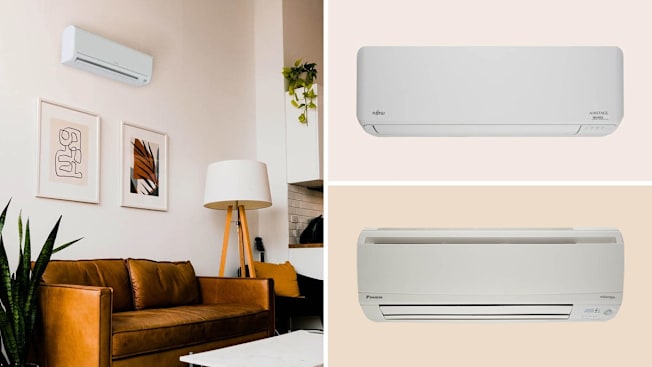Best Mini-Splits of 2025
Also called ductless air conditioners, these units are a good option for keeping your space cool if you lack ductwork
When you shop through retailer links on our site, we may earn affiliate commissions. 100% of the fees we collect are used to support our nonprofit mission. Learn more.

If your home isn’t equipped for central air conditioning, mini-splits may be a smart alternative, particularly if you don’t want to install and remove clunky window units each season. Mini-splits, also known as ductless air conditioners, can cool large spaces quickly and quietly.
Mini-splits are a type of heat pump. They cool your home by taking heat from the indoor air and sending it outside. They can also heat your space by working in reverse: They absorb heat from the outside air and move it indoors. (The heat gets transported in either direction through a refrigerant line.)
These systems come in two parts. There’s an outdoor compressor that’s connected to an indoor unit, called an air handler. There are multiple types of air handlers, including ones that can mount to a wall, the ceiling, or the floor. Some mini-split systems have compressors that can support multiple air handlers indoors. That means you could have air handlers cooling different rooms inside with only one compressor outside. If you want to cool multiple zones, installing a system that can handle multiple indoor units can save you money. (And who wants multiple compressors outside their house if they can help it?) You can also size a system according to your needs, for example, if you want one unit for a small apartment or an open-concept kitchen-living room area.
The mini-splits in our ratings range from $750 to more than $2,200, not including installation costs. These prices are far more than those for portable or window air conditioners, but mini-splits are designed to cool large spaces and run for long periods, giving you a feeling closer to central air conditioning. Because they can heat, too, they can also supplement, or in some cases replace, your home’s heating system.
Most mini-split systems require professional installation, though some models on the market are designed for DIY installation. (Keep in mind that DIY models still require relatively precise installation work, which we describe below.) We tested a variety of both kinds. One important note: For either type, check your local building codes and make sure you obtain the necessary permits for installation.
Best Mini-Splits
We evaluated 10 mini-split models for how quickly they could cool and heat a room. All of the models we tested had air handlers designed to mount to a wall (as opposed to the floor or ceiling).
Best DIY Mini-Split
Seven of the models we tested require professional installation, and three are DIY. Our experts recommend installation by an HVAC professional in most cases. Even DIY mini-splits require some expertise, given the multiple steps involved with properly placing and installing an indoor unit, outdoor compressor, copper lineset (for carrying refrigerant), electrical wiring, and condensate drain pipe. A mini-split should also have a dedicated electrical line.
One of the DIY models we tested is a MrCool option that comes with a copper line prefilled with refrigerant from the factory. That eliminates the step of vacuuming the line to clear it of any moisture or impurities before installation. But keep in mind you’ll still need to follow the other steps above.
What Size Mini-Split Do You Need?
When researching mini-splits and determining the system you’ll need, consider this: How much cooling do you want?
If you’re looking to cool several different rooms, you will want to ask an installer about a multi-zone system, where one compressor can support multiple indoor air handlers. And whether you’re looking to cool a few rooms or just one, you need to consider the space itself, says Chris Regan, who oversees mini-split testing at Consumer Reports.
Mini-Split vs. AC Unit: Which Is Better?
Window and portable air conditioners are still some of the least expensive and simplest ways to keep rooms cool on hot days. They very capably provide air conditioning on a modest budget. We have ratings for 75 window and portable ACs and guidance on how to choose the right one for your space.
But those units are also heavy, loud, and conspicuous compared with mini-splits and central air. Did we mention heavy? Window ACs weigh about 40 to 80 pounds or more. If you’re storing them properly in the off-season, plan on moving them around at least twice a year.
Mini-splits offer a more fixed option for cooling air. The units are set in place, ideally in an easily overlooked spot, and you control them with a remote. Like central AC, a mini-split system is designed to run for long periods and cool larger spaces efficiently. They work quickly to lower a room’s temperature and do so rather quietly. (During testing, we could barely tell whether some of them were working when running on lower fan speeds.)
If you’re a homeowner trying to achieve a more uniform temperature in your home, then mini-splits may be a good investment. One from a reputable manufacturer can last about 10 to 15 years, possibly longer. They’re less expensive and simpler to install than central air conditioning because you don’t have to open up walls to put in ductwork. Mini-splits are also more energy-efficient than central air because cooled air doesn’t escape through ducts. Those energy losses account for about 30 percent of central air’s energy consumption, according to the Department of Energy. Plus, mini-splits that meet certain energy-efficiency criteria are eligible for a federal tax credit, but only until Dec. 31, 2025.
How CR Tests Mini-Splits
We test mini-splits using two temperature-controlled chambers in our labs. To test the cooling mode, the outdoor compressor is placed in a chamber set to 95° F with high humidity, mimicking a hot and muggy summer day. The indoor air handler is mounted in a second chamber at a starting temperature of 90° F. We evaluate how quickly the mini-split lowers the temperature of the room by 10° F. We then set the mini-split to 75° F and evaluate how well the unit can maintain that temperature over 12 hours, averaging results over multiple runs. We also measure the total kilowatt-hours of electrical energy used over that time period to determine the mini-split’s energy consumption.
To test the heating mode, we put the compressor in a chamber set to 40° F and the indoor unit in a chamber set to 60° F. We measure how much the mini-split can increase the temperature of the room over 15 minutes.




























